#71: 1901 Charleston Exposition, the Swamp Rabbit Trail, and Thunder In The Harbor
For South Carolina history lovers far and wide! Enjoy weekly SC history and upcoming SC historical events
Welcome to the first 100 days of the South Carolina History Newsletter! My name is Kate Fowler and I live in Greenville, SC. I have a 9-5 job in marketing, and outside of work, have a deep love of history. I started this newsletter as a passion project to learn more about our beautiful state and build a community of fellow SC history lovers along the way! To establish a foundation for the newsletter and to grow my expertise on a wide variety of South Carolina historical topics, this past February I challenged myself to post 100 newsletters in 100 days. After this coming May 20th, the newsletter will become weekly. Thank you for joining the journey!
Dear reader,
Welcome to Newsletter #71 of The South Carolina History Newsletter! I’m so happy you’re here.
4/21/24 update from Kate: unless y’all feel really strongly about this, I’ve decided to stop my audio sections of the newsletter because while they were fun, I got a sense that people mostly read the newsletter and the audio portions weren’t as helpful as I had hoped. Though I still have a dream to make an accompanying podcast to the newsletter someday! :)
As always, I’d like to also extend a special welcome to the following new subscribers — woohoo! Thank you for subscribing.
Coho1992
marymarthagreene
saxtont66
asctw1
srboseman1
I hope you enjoy today’s newsletter, and as always, please feel free to reply to this email with your ideas and suggestions on South Carolina history topics you’d like to learn more about. I’m only a click away.
Additionally, please join us & keep the conversation going by becoming a member of our SC History Newsletter Facebook Community here! I can’t wait to meet you.
And now, let’s learn some South Carolina history!
Yours truly,
Kate
(Writing from Greenville, SC)
➳ Featured SC History Event
Please enjoy our featured SC History Event below, and click here to visit my SC History Events Calendar that organizes all the upcoming SC history events I have discovered. Please let me know if you’d like to add an event to the calendar! Reply to this email or send me a note at schistorynewsletter@gmail.com.
Wednesday, May 8th | “Thunder In The Harbor: Fort Sumter and the Civil War” | Old Exchange and Provost Dungeon | Charleston, SC | FREE Admission
“Join author Rick Hatcher for three evening lectures following the release of his new book, Thunder in the Harbor on Wednesdays, May 8, 15 and 22 at 6:00 pm in the Great Hall of the Old Exchange and Provost.
Wednesday, May 8: Thunder in the Harbor
Wednesday, May 15: The Life of Major Robert Anderson
Wednesday, May 22: The Life of Brig General PGT Beauregard
The lectures are free but registration is requested. Books will be on sale in the gift shop. The event is proudly sponsored by the Old Exchange and Provost, South Carolina Historical Society and Friends of Charleston National Parks.”
➳ SC History Fun Facts
I.
Did you know that the 1901-1902 Charleston Exposition was put together in an effort to revitalize the Charleston economy, which had been in sharp decline since the Civil War?
Charleston at the turn of the 20th century was in a steep decline. The Civil War had ravaged the city both physically and economically. On top of that, in 1886, there was a massive 7.0-magnitude earthquake in Charleston that killed 60 people, injured many more, and caused damage to 2,000 buildings, causing millions of dollars in damage. The city was falling apart.
Because of the 1886 earthquake and other natural disasters that befell the city, Charleston port was seen as a risk to trade, and the volume of trade “declined from $98.5 million during 1890-91, to $29.5 million by the turn of the 20th century.”
Charleston needed a boost of economic energy and publicity. Enter Frederick W. Wagner. He was a “wealthy wholesale grocer” who was inspired by the fairs he had seen in cities like Atlanta and Georgia. He who took it upon himself to organize the “South Carolina Interstate and West Indian Exposition” which was held from December 1901, until June 1902 (6 months!). It would later just be referred to as the Charleston Exposition.
The Charleston Exposition was situated on a 185-acre site in the “western portion of Charleston” where it was key that attendees had a view of the “newly rebuilt Charleston harbor, illustrating the city’s readiness for increased trade.” The goal was to re-establish Charleston as a prominent American port, as it had been in the past.
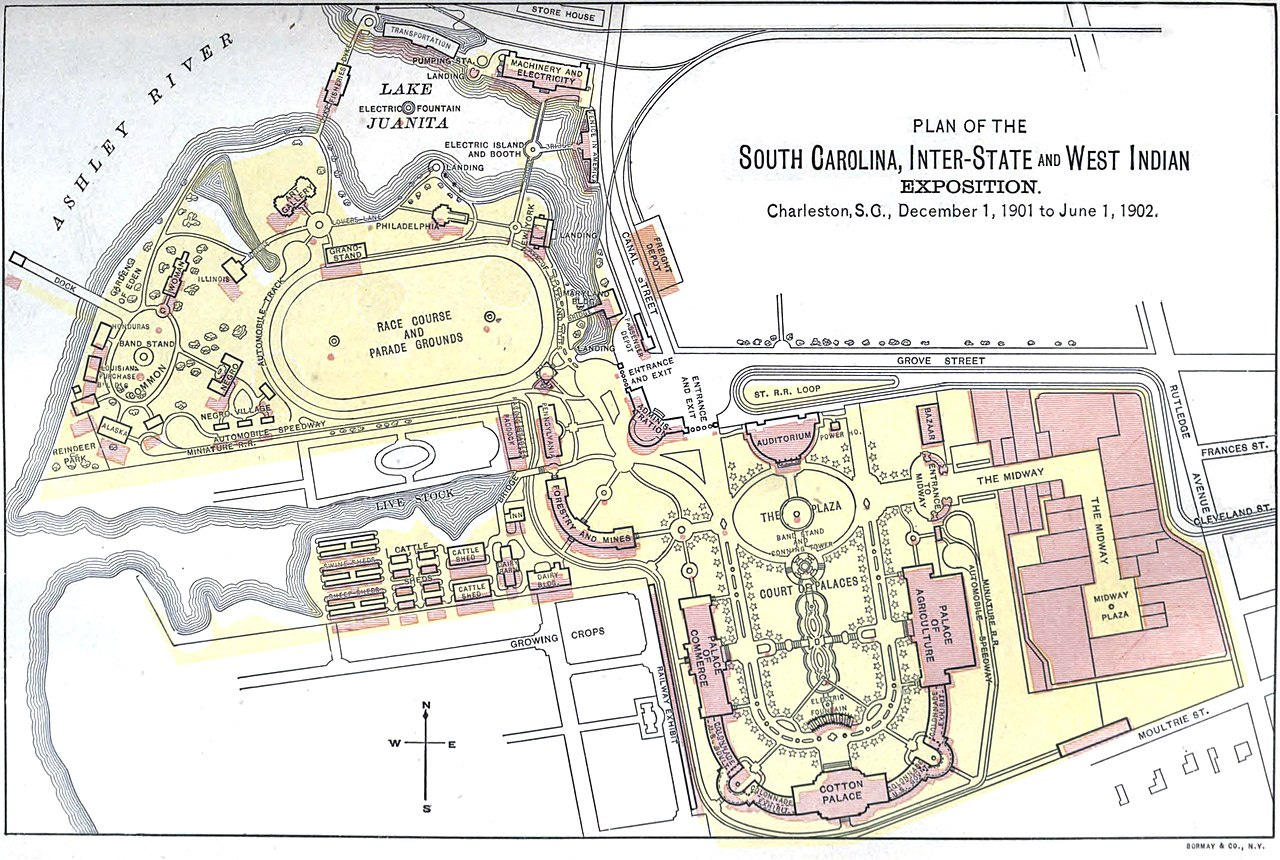
From the Citadel Digital Archives, here is a description of the Charleston Exposition:
“The exposition’s buildings were designed to display the most recent technology for machinery, transportation, agriculture, and more. The exposition’s “Nature” area was located on old farmland near the Ashley River, and comprised the Art Building, the Negro Building, the Woman’s Building, and the numerous buildings built by participating states. The “Art” area was located to the southeast, on the former Washington Race Course grounds. Within this section was the main feature of the Charleston Exposition: The Cotton Palace, a 350-foot long building with a 75-foot tall dome. Its purpose was to highlight all aspects of cotton and its use, increasing interest in Charleston’s cotton industry. Other prominent buildings in this area were the Palace of Commerce and the Palace of Agriculture. These buildings were designed as representatives of the Exposition’s entire image, and it is estimated that over 3,000,000 feet of lumber went into building the eventual court of great palaces on site; the alabaster finish on these grand buildings gave the Charleston Exposition its Nickname “The Ivory City”. Additional features included a zoo, and an auditorium that seated 6,000 people. The midway had a carnival with thrill rides and an Eskimo village, and the Miniature Railway company transported visitors throughout the Charleston Exposition’s various sites via miniature locomotive and cars.”

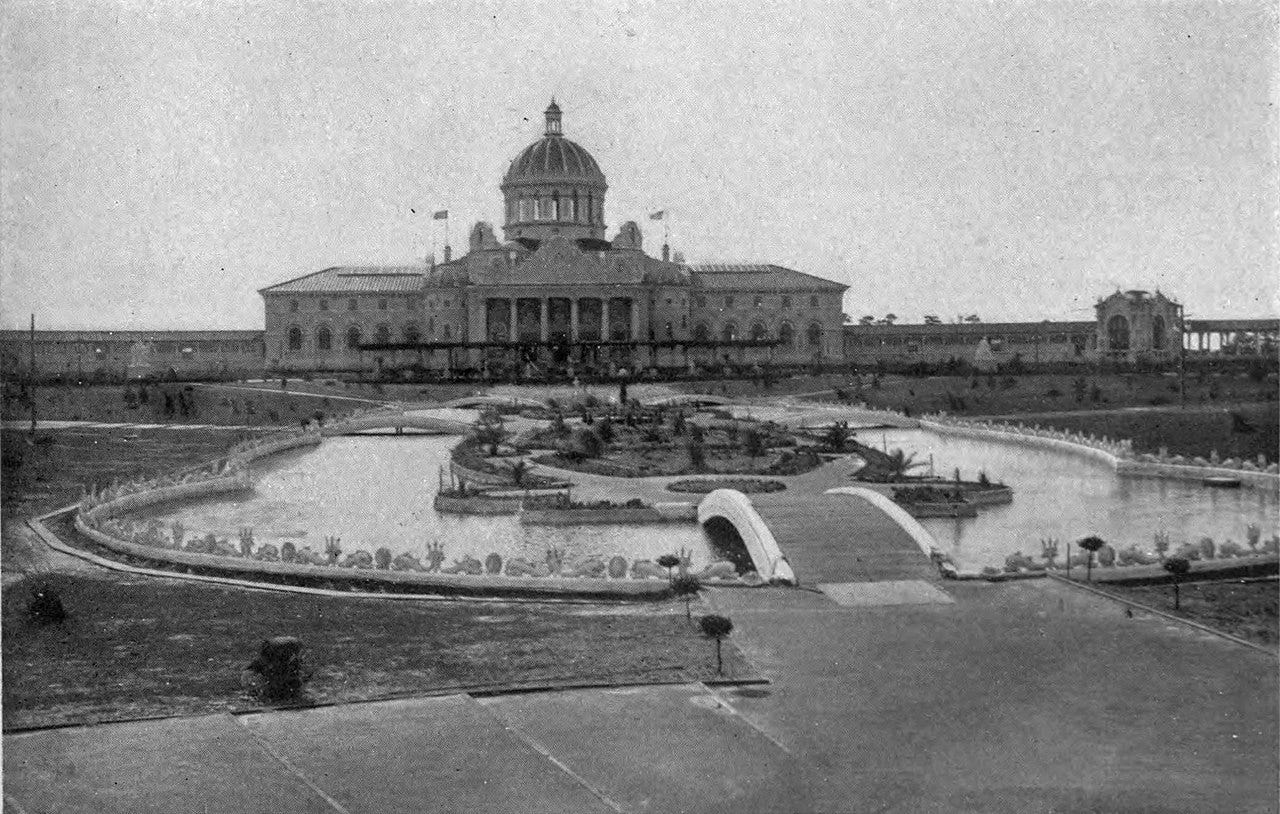
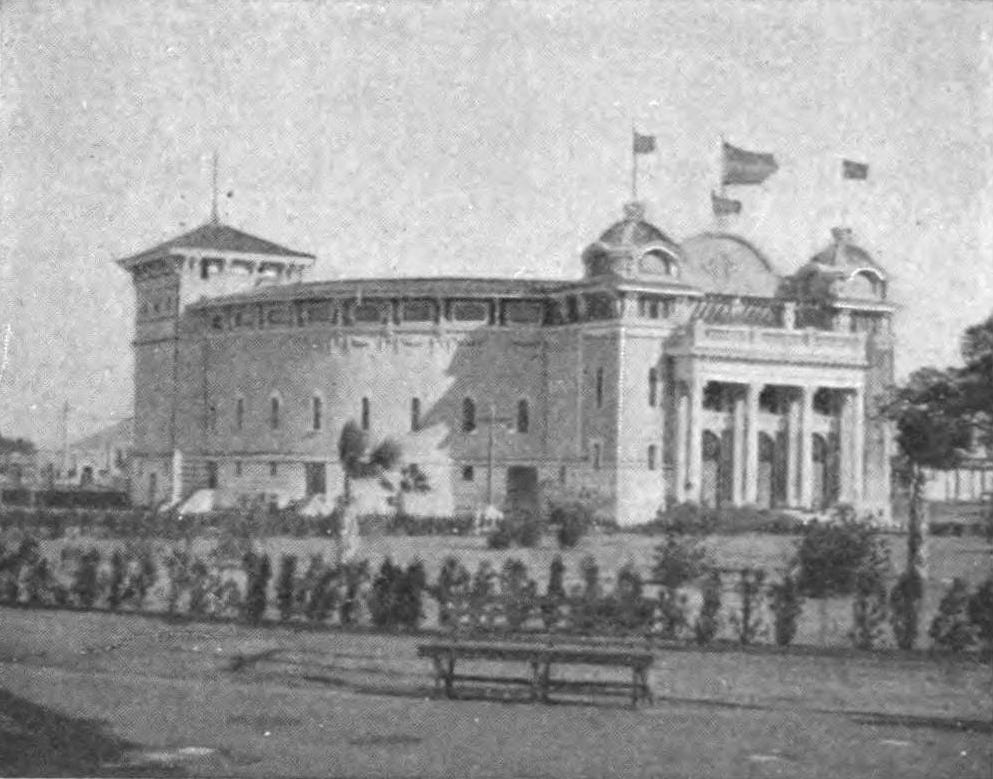
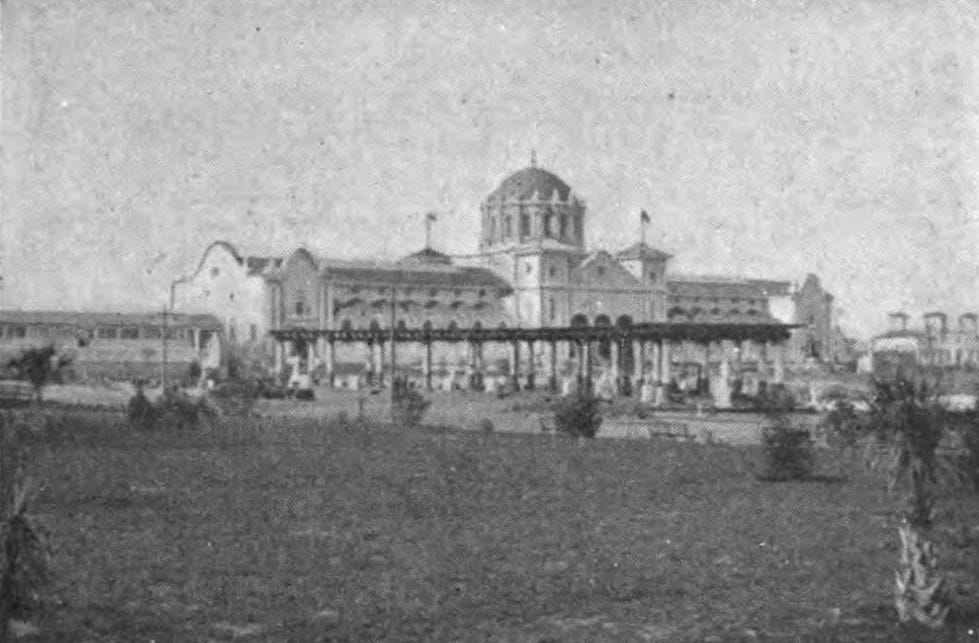
In addition to all the excitement described above, the Liberty Bell was brought in from Philadelphia to Charleston and was put on display at the exposition.
20 states participated in the exposition, and to highlight Charleston’s desire to further open trade with the West Indies, there were “special exhibits were devoted to Cuba, Puerto Rico, and Guatemala.”
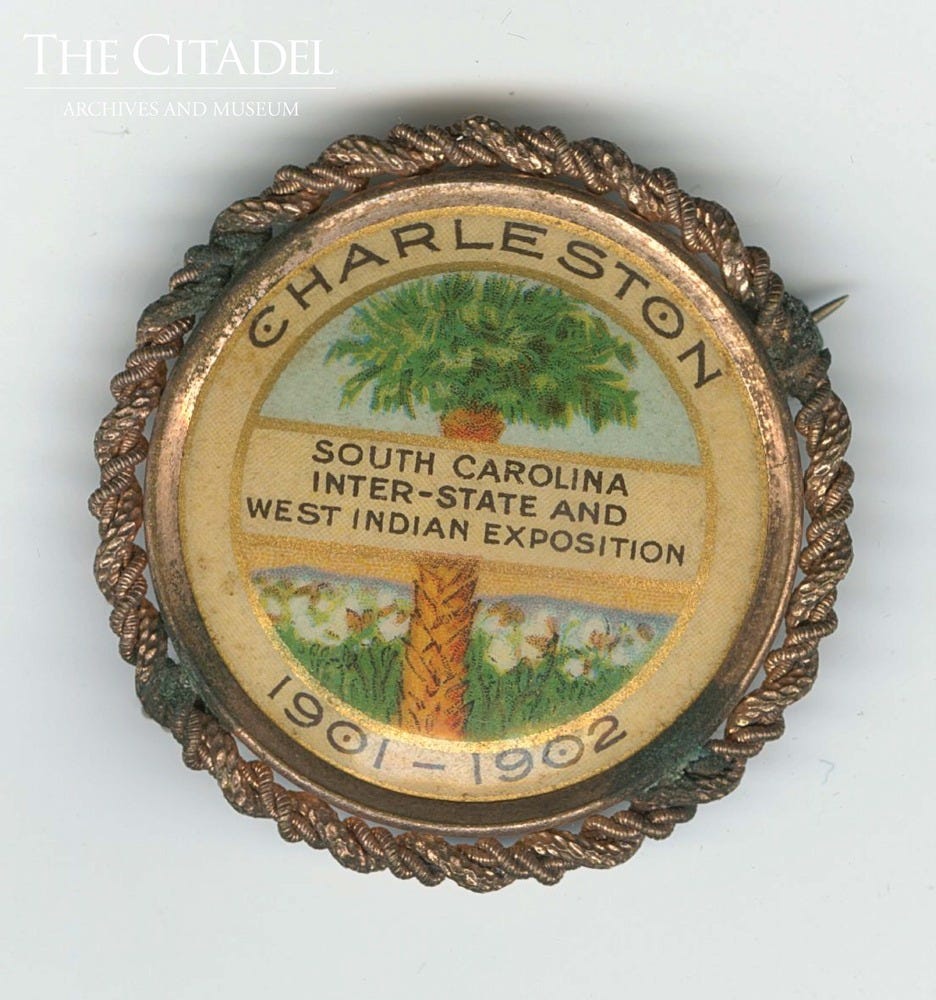
Notable figures attended the exposition including President Theodore Roosevelt and Mark Twain.
On April 9, 1902, President Roosevelt made a moving speech at the Exposition that covered a variety of topics from The Civil War, to Charleston’s trade with the West Indies, to America’s Industrial Revolution, and more. 1902 was only 37 years after the end of the Civil War, and Roosevelt makes a concerted effort to include unifying language throughout his speech. I encourage you to read the full speech text here. And I’d like to share a few paragraphs that were particularly poignant:
Mr. President, Mr. Mayor, and you the men and women of the Palmetto State, men and women of the South, my fellow citizens of the Union:
It is indeed to me a peculiar pleasure to have the chance of coming here to this Exposition held in your old, your beautiful, your historic city. My mother's people were from Georgia; but before they came to Georgia, before the Revolution, in the days of Colonial rule, they dwelt for nearly a century in South Carolina; and therefore I can claim your State as mine by inheritance no less than by the stronger and nobler right which makes each foot of American soil in a sense the property of all Americans.
Charleston is not only a typical Southern city; it is also a city whose history teems with events which link themselves to American history as a whole. In the early Colonial days Charleston was the outpost of our people against the Spaniard in the South. In the days of the Revolution there occurred here some of the events which vitally affected the outcome of the struggle for Independence, and which impressed themselves most deeply upon the popular mind. It was here that the tremendous terrible drama of the Civil War opened.
With delicate and thoughtful courtesy you originally asked me to come to this Exposition on the birthday of Abraham Lincoln. The invitation not only showed a fine generosity and manliness in you, my hosts, but it also emphasized as hardly anything else could have emphasized how completely we are now a united people. The wounds left by the great Civil War, incomparably the greatest war of modern times, have healed; and its memories are now priceless heritages of honor alike to the North and to the South. The devotion, the self-sacrifice, the steadfast resolution and lofty daring, the high devotion to the right as each man saw it, whether Northerner or Southerner all these qualities of the men and women of the early sixties now shine luminous and brilliant before our eyes, while the mists of anger and hatred that once dimmed them have passed away forever.”
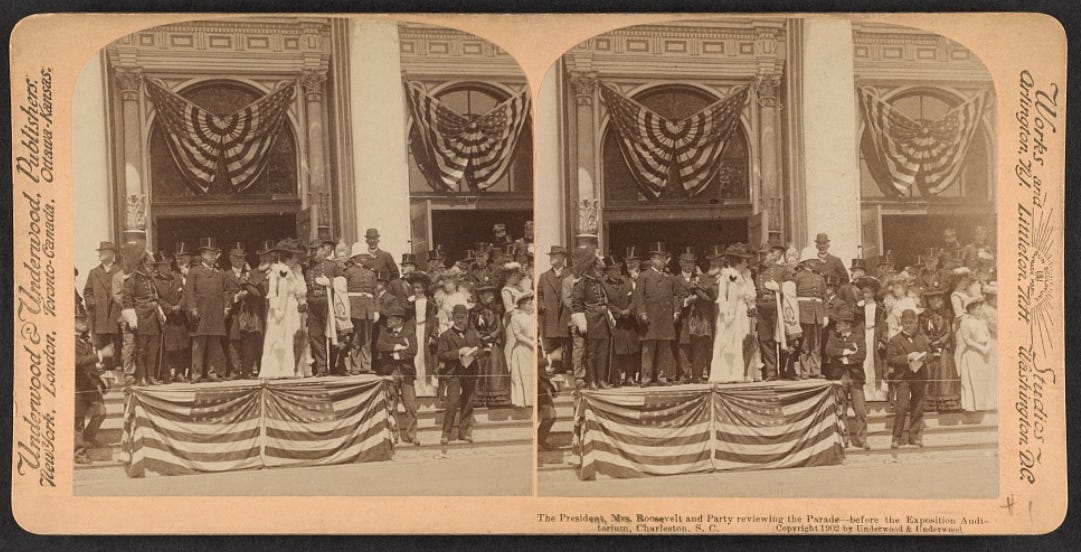
For all the planning, publicity, investment, and hoopla, unfortunately the Charleston Exposition was not as successful as its organizers had hoped. 674,086 attendees came to the exposition over the course of the exposition’s 6 months from December 1901, until June 1902. It also didn’t help that Charleston also had a brutal winter in 1901.
The largest attendance day was on May 22, 1902 with 25,000 visitors.
The Charleston Exposition had “funding issues” from the start, and at the end of it, the buildings were removed and materials were sold to help pay off accumulated debts.
The Charleston Exposition Company, which created the exposition, went bankrupt.
A portion of the exposition’s land was bought by the City of Charleston, which created Hampton Park. Inside the park is the bandstand from the Charleston Exposition, though it has been removed from its original spot and rebuilt. Portions of the exposition’s zoo, after removal, were sent across the Ashley River to the Charles Towne Landing site, owned by The State of South Carolina.

In 1919 the State of South Carolina obtained the western portion of the former Charleston Exposition site, which became the new campus for today’s Citadel.
Please scroll to the bottom of this email for my source for this section
Please leave a comment below!
II.
Did you know that without the efforts of local conservationists, Greenville County’s beloved Swamp Rabbit Trail would never have existed?
A formerly defunct railroad track, the Swamp Rabbit Trail is now a beloved 20-mile multi-use “greenway” bike and walking trail in Greenville County, South Carolina that provides a wonderful outlet for physical activity, unites Upstate communities, and also brings in millions of dollars in tourism revenue to the county each year.
The trail begins at Greenville Technical College, crosses the city of Greenville, proceeds through Falls Park and the campus of Furman University, and ends about a mile north of the Travelers Rest city limits.
We owe a huge thank you to local conservationist and Upstate Forever organization founder Brad Wyche and many other Greenville County stakeholders for championing this project, which almost never came to fruition.

For “several decades” there was a railroad, with the popular nick name “the Swamp Rabbit” that operated “from downtown Greenville to River Falls.” The railroad was named after a large cottontail rabbit native to the region.
In 1998, the railroad company Railtex ceased its operations and was prepared to put the whole line on the market. This became Upstate Forever’s first big conservation project. Brad Wyche saw this as “a breathtaking, once-in-a-lifetime opportunity for the Greenville community and the Upstate — a chance to acquire the entire line and turn it into a trail connecting downtown to Furman and Travelers Rest.”
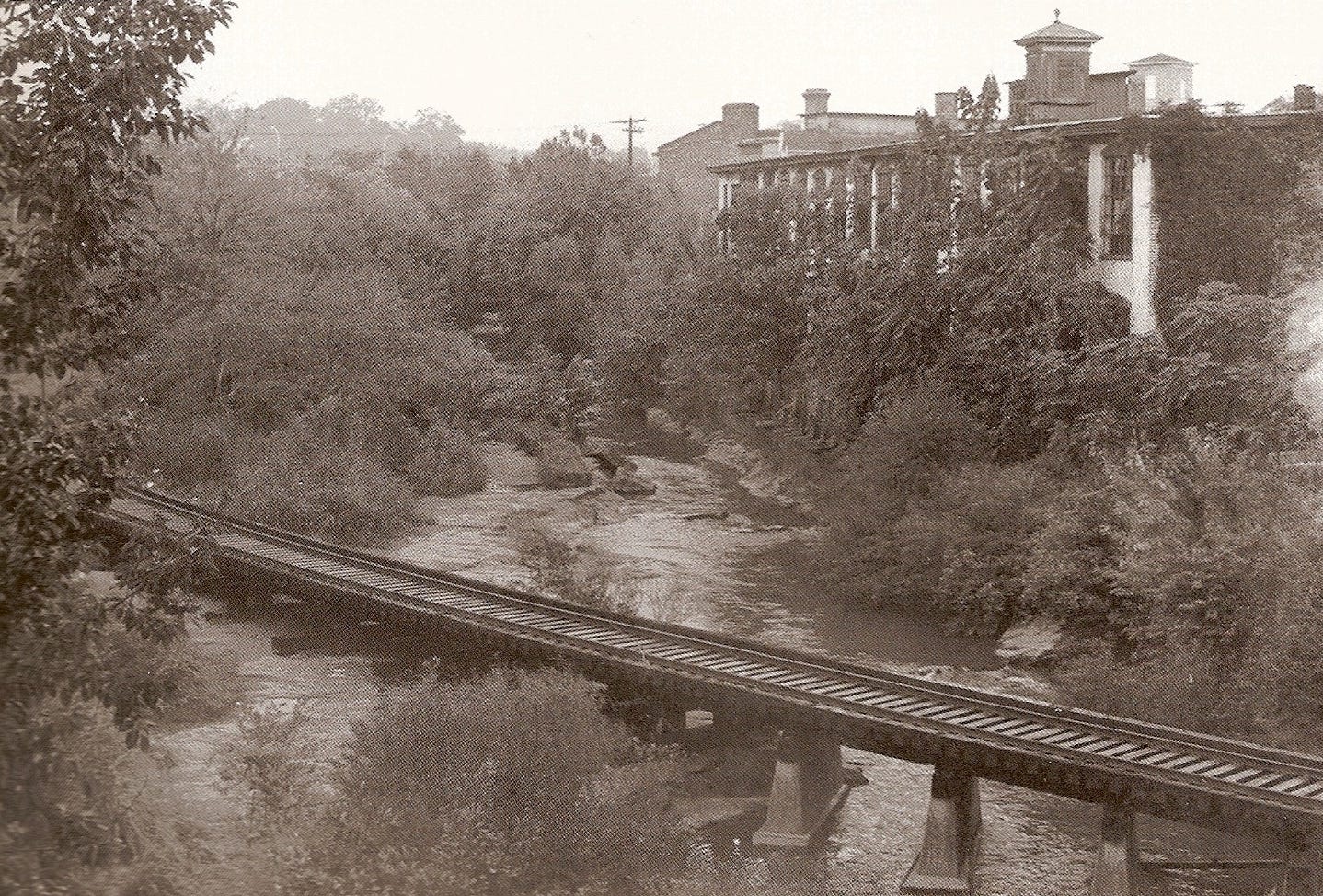
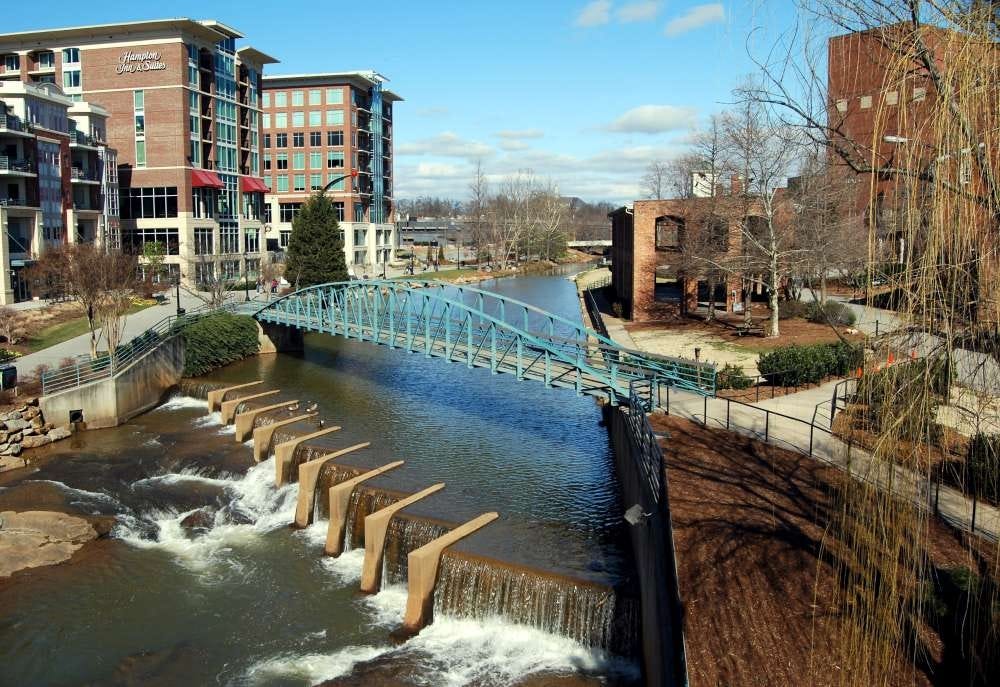
The first positive step occurred when the Greenville County Economic Development Corporation (GCEDC) purchased the abandoned rail line in 1999.
Then, former Upstate Forever Board Chair Carleton Owen organized a group of volunteers to work “every Saturday throughout the summer of 2005 to clear away the kudzu, briars and bushes from almost the entire length of the line.” The effort was key to building strong public support for the establishment of a trail.”
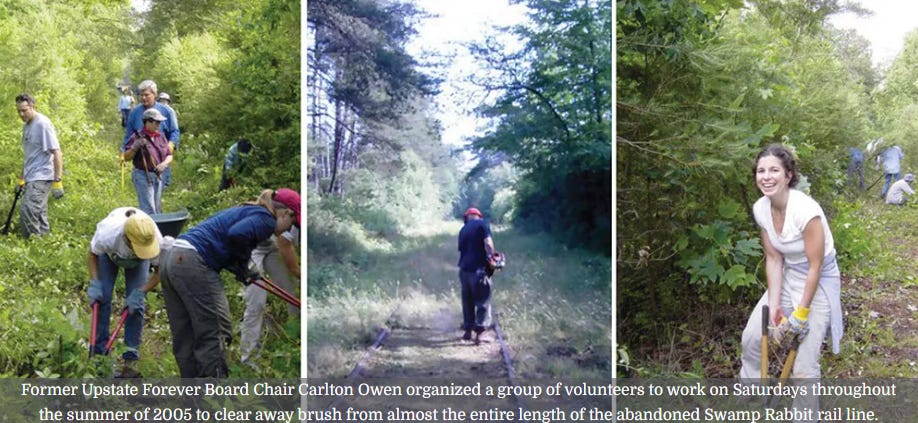
The last step was for the GCEDC to file a petition for abandonment of the trailway with the Surface Transportation Board (STB).
Under federal law, before a rail line can be abandoned, “an opportunity must be given to any interested company or person to acquire the line at fair market value and resume rail service.” To the project leaders’ dismay, a private railroad firm in Greenville sought to buy the entire line at a nominal price and resume commercial freight service.
GCEDC and Upstate Forever strongly opposed the request and submitted appraisals showing that the line had substantial value. The STB agreed and established the value at over $700,000, which had to be paid by April 2006.
The suspense escalated as the project organizers waited for the private railroad firm to possibly make a bid for the line. With 24 hours left until the deadline, “We were literally counting down to midnight,” said Brad Wyche.
Thankfully the private railroad company was never heard from again, and in April 2006, the Surface Transportation Board signed an order approving the abandonment of the rail line.
Upstate Forever then agreed to serve as the “interim trail operator” to give GCEDC and the Greenville County Recreation District time to work out a final agreement for removing the rail lines and building the trail.
In 2007, the Greenville Health System made a significant gift of $1 million for the project, and the project was officially named the Greenville Health System Swamp Rabbit Trail.
The trail officially opened in 2009 and it has become a huge source of pride to the Upstate and beyond.
“The trail has been a success on many levels and a true source of pride," says Ty Houck, Greenville County Director of Greenways, Natural and Historic Resources. "Communities throughout the county have noticed the economic development associated with the trail, and now they want to connect to it to become partners with this iconic community asset."
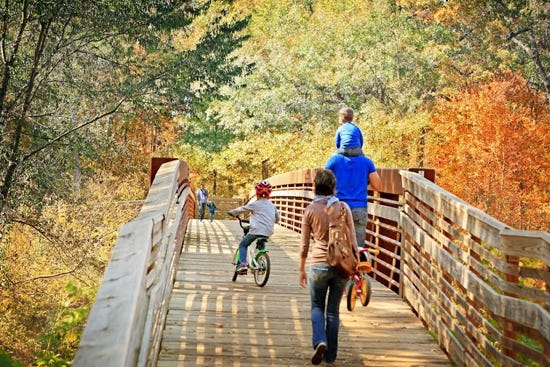
A 2012 study estimated that more than 350,000 people annually used the trail and that area businesses increased their sales from 30 to 85%.
A 2014 study estimated usage had increased to half a million people a year, a quarter of whom were tourists.
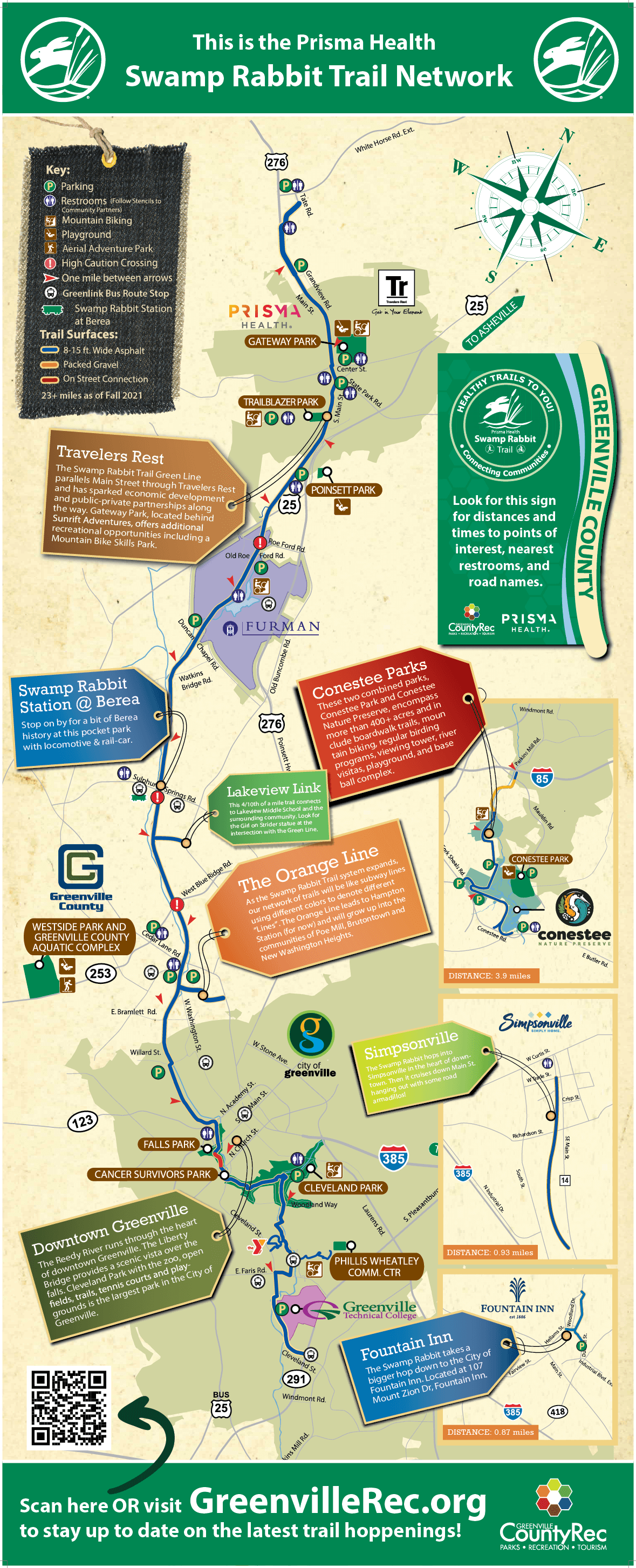
In 2013, the mayor of Travelers Rest said that the trail had "been phenomenal for the whole county, but more so for us in Travelers Rest. I can't begin to tell you how much of an economic boost it's been to this town.”
A 2012 Greenville News editorial described the Swamp Rabbit Trail as "one of the most popular assets in Greenville County...proving that when it comes to such trails, if you build them they will come."
In 2016, Greenville County Recreation estimated the trail's economic impact on the county to be $7 million per year.
Among Greenville’s many accolades over the last few years, in February 2024 it was ranked #6 in Southern Living Magazine’s “South’s Best Cities 2024 List”, surpassing cities like Atlanta, Austin, and Raleigh. The article wrote:
"Greenville is at the center of everything. You can be in Asheville in an hour, Atlanta in two, and Charleston in three. But with the city's gorgeous Falls Park on the Reedy, a walkable and lively downtown, and the 22-mile Swamp Rabbit Trail connecting major attractions throughout the city, there's really no reason to leave.”
As someone who proudly lives in Greenville, I want to say a huge thank you to Brad Wyche and Upstate Forever for fighting for their vision, which has now become our beloved Swamp Rabbit Trail, that keeps us healthy and moving, and is at the heart of our community!
Please scroll to the bottom of this email for my sources for this section
Please leave a comment below!
➳ Quote from an SC historical figure
“And now, my fellow-countrymen, in closing I am going to paraphrase something said by Governor Aycock last night. I have dwelt today upon the fact that we are indeed a reunited people; that we are indeed and forever one people. The time was when one could not have made that statement with truth; now it can be truthfully said. There was a time when it was necessary to keep saying it, because it was already true, and because the assertion made it more true; but the time is at hand, I think the time has come, when it is not necessary to say it again. Proud of the South? Of course we are proud of the South; not only Southerners, but Northerners are proud of the South. Proud of your great deeds? Of course I am proud of your great deeds, for you are my people. I thank you from my heart for the welcome you have given me, and I assure you that few experiences in my life have been more pleasant than the experiences of these two days that I have spent among you.”
—On April 9, 1902, final paragraph of President Roosevelt’s speech at the Charleston Exposition
1901 Charleston Exposition article sources:
Harvey, Bruce G. “South Carolina Inter-State and West Indian Exposition | South Carolina Encyclopedia.” South Carolina Encyclopedia, https://www.scencyclopedia.org/sce/entries/south-carolina-inter-state-and-west-indian-exposition/. Accessed 21 Apr. 2024.
“History of the South Carolina Inter-State and West Indian Exposition · The South Carolina Inter-State and West Indian Exposition of 1901-1902 · The Citadel Archives Digital Collections.” The Citadel Archives Digital Collections, https://citadeldigitalarchives.omeka.net/exhibits/show/exposition-home-page/charleston-exposition-history. Accessed 21 Apr. 2024.
Swamp Rabbit Trail article sources:
Hallo, Lisa. “The Trail That Almost Wasn’t.” Upstate Forever, 26 Oct. 2018, https://www.upstateforever.org/blog/land-planning-policy/the-trail-that-almost-wasnt. Accessed 21 Apr. 2024.
“Prisma Health Swamp Rabbit Trail - Greenville County Parks Recreation & Tourism.” Greenville County Parks Recreation & Tourism, https://greenvillerec.com/swamprabbit/. Accessed 21 Apr. 2024.
“Prisma Health Swamp Rabbit Trail Rail-Trail History.” TrailLink: Trail Maps & Guide for Biking, Hiking & Running Trails, https://www.traillink.com/trail-history/prisma-health-swamp-rabbit-trail/#:~:text=The%20curiously%20named%20Swamp%20Rabbit,struggled%20to%20earn%20sustained%20profits. Accessed 21 Apr. 2024.
I always want to improve my work. Answer the poll below to give me your review of today’s newsletter. I also welcome your suggestions for new content! Simply reply to this email with your ideas. Thank you!




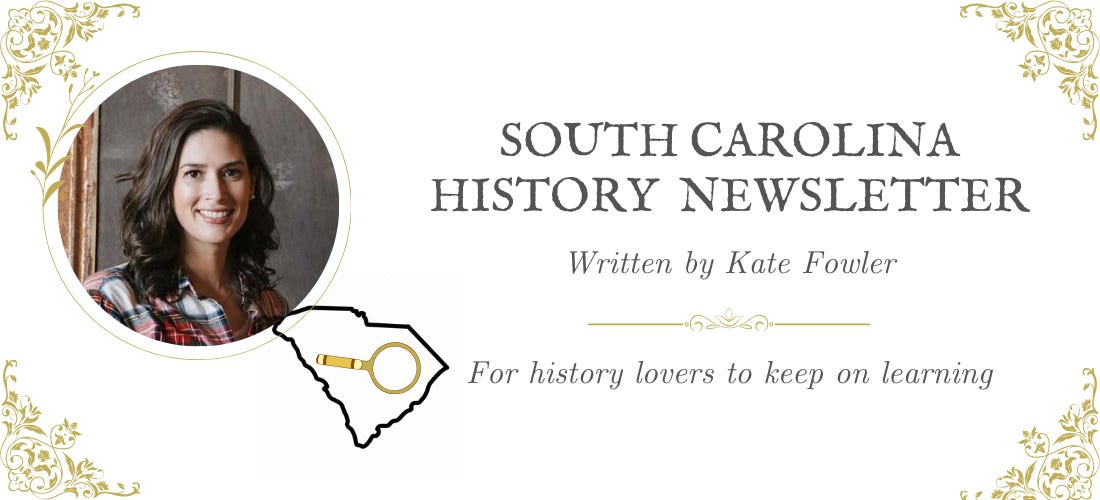


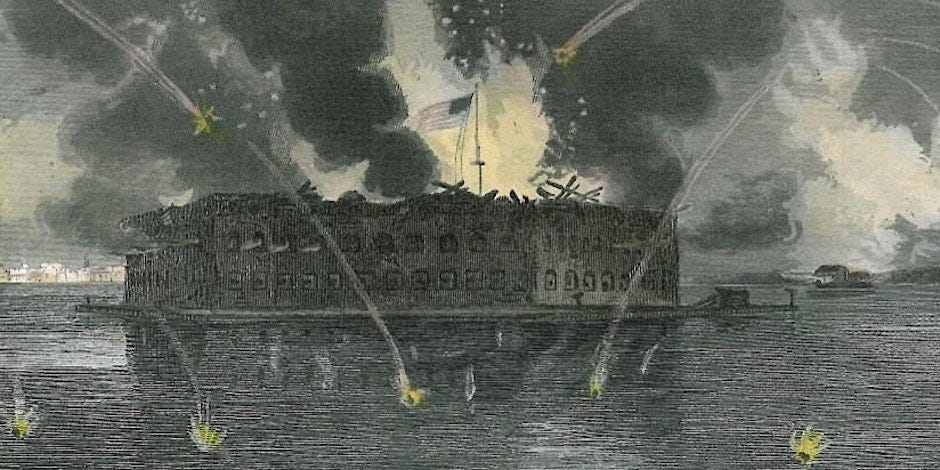





The other side of the story for the swamp rabbit trail is that the property owners who shared a property line with the railroad supposedly their deed said if ever railroad abandoned then the rail land would revert back to the property owner. Some of these owners were upset with what happened to make the swamp rabbit trail. So I hear this is other side of story.